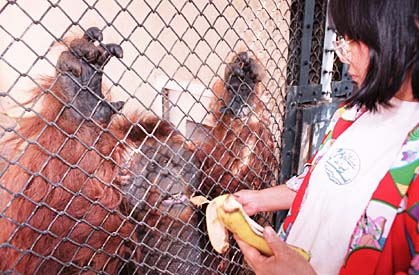


Rusti eagerly HILO >> Rusti the orangutan's ape skills have been getting rusty at the Honolulu Zoo, but the patient primate could be happily up a tree in Hilo by the end of the summer.
awaits greener
pastures
The Oahu resident is
A contrast to conditions abroad
likely to be transferred
to Hilo this summerBy Rod Thompson
Star-BulletinIn 1997, Rusti was rescued from a filthy, prisonlike cell in a private New Jersey zoo and brought to a "temporary" home at the Honolulu Zoo.
Volunteers have kept Rusti mentally stimulated at the zoo since then, but he is housed in a 1950s cage which zoo officials are eager to tear down. In Hilo he would have up to an acre of non-native forest in which to roam.
Since 1993 the Orangutan Foundation International has worked on plans for a sanctuary just outside Hilo for apes like Rusti.
Spokesman Steve Karbank said the foundation hopes to start construction in two or three weeks next to Hilo's Panaewa Rainforest Zoo.
"Actual construction won't take long," he said. Rusti could be in the facility by fall.
The 28-acre sanctuary is the dream of world-renowned primatologist Birute Galdikas, who has made orangutans her life's work.

Although Galdikas is from Canada and orangutans are from Indonesia, Galdikas fixed on Hilo at the suggestion of her volunteer assistant Charlotte Grimm, who moved to Hilo in 1991.Hawaii County signed a letter of intent to cooperate with Galdikas in 1993, but a lease at Hilo's zoo was not signed until 1999, and a building permit was not granted until a few weeks ago.
At least one hurdle remains. The state Department of Agriculture must approve a permit to transfer Rusti to Hilo. That permit defines the conditions for housing Rusti and other orangutans, including a mesh netting around their enclosures, said Andy Levin, assistant to Harry Kim, the Big Island's mayor.
Karbank said the mesh is steel with a vinyl-like coating that has holes too small for orangutans, or people, to get their fingers through, so they cannot climb it. It is already used in security situations such as military bases, he said.
State agriculture official Domingo Cravalho said two committees have to review the permit, a public hearing will be scheduled, and a decision could be made by the end of July.
Plans call for each orangutan to have one-half to one acre of forest to roam during the day. They would be trained to return to a sleep-house at night.
The Orangutan Foundation application asks that Rusti be allowed to live in the sleep-house full time until his larger compound is completed, Cravalho said.
After Rusti, four more orangutans would arrive over the following six months, Karbank said. Later, the facility would be expanded to house 20 orangutans. A staff of about five people would be hired locally, he said.
"We have enough money to get Rusti moved over and housed," Karbank said.
The foundation's web site, www.orangutan.org, includes an "urgent" appeal for $750,000. That is fund raising for additional construction, Karbank said.
A $1 million state appropriation obtained by then-Sen. Levin in 1998 has lapsed, Levin said. The facility will be entirely privately funded, Karbank said.
HILO >> An orangutan sanctuary in Hilo is designed to give captive American orangutans a decent home. Rusti’s bright future
a contrast to current
conditions abroadStar-Bulletin staff
Their species' home in Indonesia is turning into a nightmare.
Although primatologist Birute Galdikas works in a national park with about 500 orangutans in Indonesian Borneo, illegal loggers, protected by corrupt military and political figures, are cutting forest in the park, says a news entry at the Web site of the Orangutan Foundation International.
The foundation had to raise $560 a day to hire people to guard the forest after a mob of loggers drove park officials out of Tanjung Puting National Park last year, the Web site says.
There are bright spots.
Indonesia placed a ban on exporting high-value ramin wood, the principal target of loggers, which should also help industrial countries to control imports.
And Congress and President Clinton last year approved $5 million to protect apes in Asia and Africa.
But some experts are predicting all wild apes could be extinct in 20 years.
"It's frightening," said Orangutan Foundation official Steve Karbank. "The captive population is, I regret to say, the future of the species."